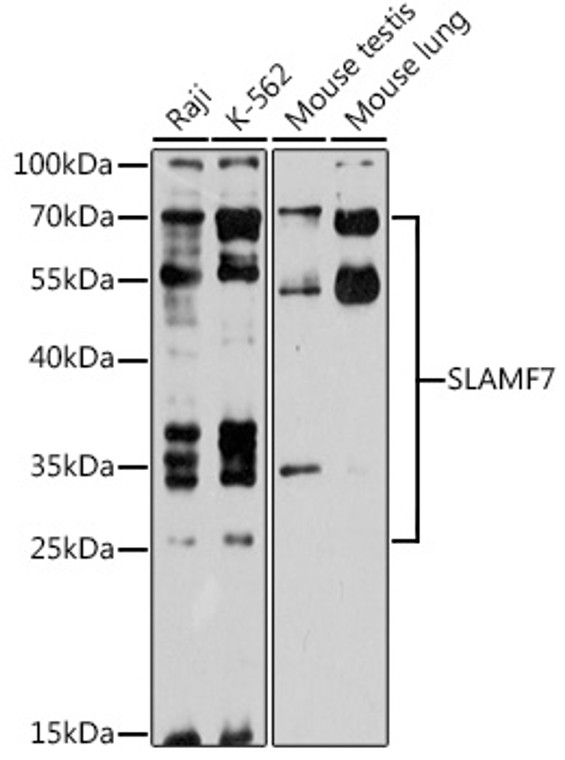| Host: |
Rabbit |
| Applications: |
WB/ELISA |
| Reactivity: |
Human/Mouse |
| Note: |
STRICTLY FOR FURTHER SCIENTIFIC RESEARCH USE ONLY (RUO). MUST NOT TO BE USED IN DIAGNOSTIC OR THERAPEUTIC APPLICATIONS. |
| Clonality: |
Polyclonal |
| Conjugation: |
Unconjugated |
| Isotype: |
IgG |
| Formulation: |
PBS with 0.01% Thimerosal, 50% Glycerol, pH 7.3. |
| Purification: |
Affinity purification |
| Concentration: |
Lot specific |
| Dilution Range: |
WB:1:500-1:1000ELISA:Recommended starting concentration is 1 Mu g/mL. Please optimize the concentration based on your specific assay requirements. |
| Storage Instruction: |
Store at-20°C for up to 1 year from the date of receipt, and avoid repeat freeze-thaw cycles. |
| Gene Symbol: |
SLAMF7 |
| Gene ID: |
57823 |
| Uniprot ID: |
SLAF7_HUMAN |
| Immunogen Region: |
23-226 |
| Specificity: |
Recombinant fusion protein containing a sequence corresponding to amino acids 23-226 of human SLAMF7 (NP_067004.3). |
| Immunogen Sequence: |
SGPVKELVGSVGGAVTFPLK SKVKQVDSIVWTFNTTPLVT IQPEGGTIIVTQNRNRERVD FPDGGYSLKLSKLKKNDSGI YYVGIYSSSLQQPSTQEYVL HVYEHLSKPKVTMGLQSNKN GTCVTNLTCCMEHGEEDVIY TWKALGQAANESHNGSILPI SWRWGESDMTFICVARNPVS RNFSSPILARKLCEGAADDP DSSM |
| Tissue Specificity | Expressed in spleen, lymph node, peripheral blood leukocytes, bone marrow, small intestine, stomach, appendix, lung and trachea. Expression was detected in NK cells, activated B-cells, NK-cell line but not in promyelocytic, B-, or T-cell lines. Expressed in monocytes. Isoform 3 is expressed at much lower level than isoform 1. |
| Function | Self-ligand receptor of the signaling lymphocytic activation molecule (SLAM) family. SLAM receptors triggered by homo- or heterotypic cell-cell interactions are modulating the activation and differentiation of a wide variety of immune cells and thus are involved in the regulation and interconnection of both innate and adaptive immune response. Activities are controlled by presence or absence of small cytoplasmic adapter proteins, SH2D1A/SAP and/or SH2D1B/EAT-2. Isoform 1 mediates NK cell activation through a SH2D1A-independent extracellular signal-regulated ERK-mediated pathway. Positively regulates NK cell functions by a mechanism dependent on phosphorylated SH2D1B. Downstream signaling implicates PLCG1, PLCG2 and PI3K. In addition to heterotypic NK cells-target cells interactions also homotypic interactions between NK cells may contribute to activation. However, in the absence of SH2D1B, inhibits NK cell function. Acts also inhibitory in T-cells. May play a role in lymphocyte adhesion. In LPS-activated monocytes negatively regulates production of pro-inflammatory cytokines. Isoform 3 does not mediate any NK cell activation. |
| Protein Name | Slam Family Member 7Cd2 Subset 1Cd2-Like Receptor-Activating Cytotoxic CellsCraccMembrane Protein Foap-12Novel Ly9Protein 19aCd Antigen Cd319 |
| Database Links | Reactome: R-HSA-198933 |
| Cellular Localisation | MembraneSingle-Pass Type I Membrane Protein |
| Alternative Antibody Names | Anti-Slam Family Member 7 antibodyAnti-Cd2 Subset 1 antibodyAnti-Cd2-Like Receptor-Activating Cytotoxic Cells antibodyAnti-Cracc antibodyAnti-Membrane Protein Foap-12 antibodyAnti-Novel Ly9 antibodyAnti-Protein 19a antibodyAnti-Cd Antigen Cd319 antibodyAnti-SLAMF7 antibodyAnti-CS1 antibodyAnti-UNQ576 antibodyAnti-PRO1138 antibody |
Information sourced from Uniprot.org
12 months for antibodies. 6 months for ELISA Kits. Please see website T&Cs for further guidance







